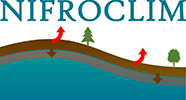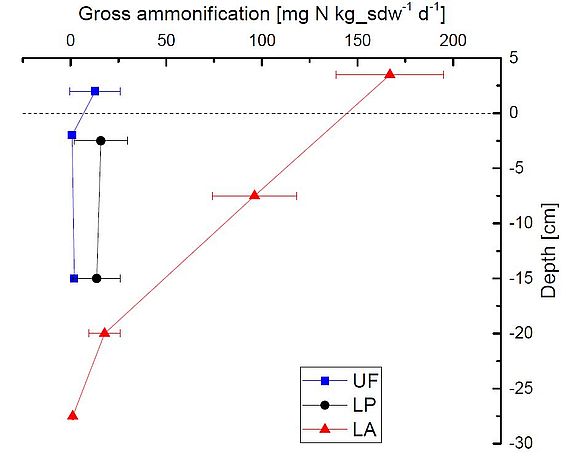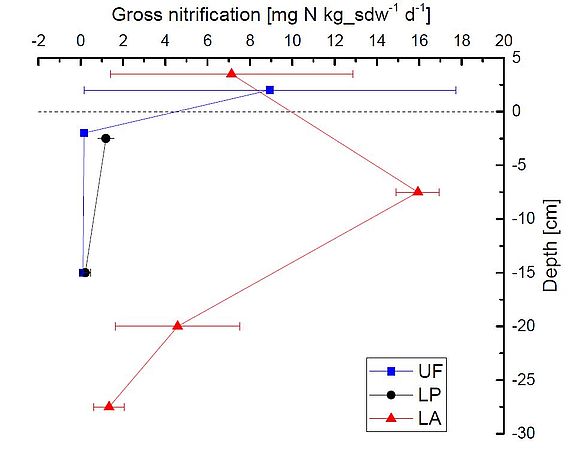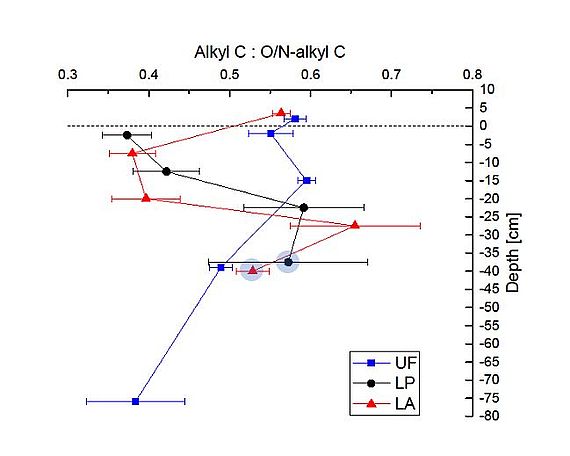Although rarely studied, the vertical dynamics of gross nitrogen (N) turnover in soil profiles may be particularly significant in permafrost soils where the water table and the freezing front act as transition zones with high biogeochemical interest for N turnover, plant N uptake, and gaseous N losses.
Here, we studied an upland coniferous forest (UF), a lowland peatland (LP) and a lowland alder forest (LA). We proposed (Ramm et al. 2022, SBB 172) that the maximum gross N turnover rates in our permafrost-affected organic lowland soils occur at the top of the active layer, where organic matter (OM) is fresh and less degraded, and at the bottom of the active layer, where labile dissolved organic carbon (DOC) is present.
With increasing depth, we found increasingly decomposed OM, while narrowing C:N ratios confirmed more microbial-biomass-derived N. As a result, more DOC was released from the topsoil. The discovery of the highest gross N turnover rates in the uppermost soil layers (Fig. 1, Fig. 2) may generally be explained by the higher C and N availability combined with less degraded OM. In particular, the topsoil of the alder forest's N-rich OM may enable larger microbial N gains for the breakdown of OM, leading to higher N mineralization. However, the tendency of declining gross N turnover with increasing depth may possibly have been influenced by declining temperatures as well.
The frozen ground in lowland alder forest (LA) plots measured at 30–50 cm depth revealed a lower decomposition than the layer 5 cm above frozen ground, defying the normal tendency of increased OM decomposition with soil depth (Fig. 3). Given that freezing appears to be the primary stability mechanism of OM in permafrost soils, this may be caused by the physical limitations of microbial breakdown activities in frozen soil. As there are only slight temperature differences between the frozen soil itself and the unfrozen soil layer directly above it, the physical freezing effect on OM protection may in fact outweigh temperature effects.
While we did not detect increased amounts of DOC trapped at the bottom of the active layer, we observed high NH4+ concentrations (Fig. 4) and contributions to total dissoved N (TDN) in deeper, frozen soil at LA. This is consistent with other permafrost investigations finding elevated NH4+ concentrations near or inside the permafrost table. The fundamental causes of such nutrient peaks in deep soil layers must be further studied.
Within the present study, our attempts to quantify gross N turnover in intact frozen soil failed as we could not achieve sufficient homogenous 15N labelling under the field lab conditions. Thus, the findings for the soil layer that was frozen had to be excluded. However, considering the high importance of NH4+ in the frozen ground layer, we propose that microbial ammonification could be a source of NH4+ in frozen ground. Particularly at the end of the extended snow-free season when active layer thickness is at its highest, permafrost thawing may loosen functional constraints on nitrifiers, allowing the NH4+ to be readily oxidized and hence susceptible to loss.




